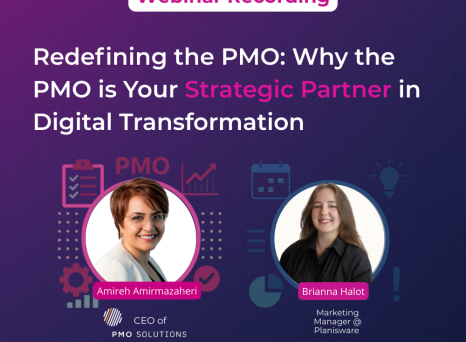Imagine you’re making cupcakes. You wouldn’t bake one at time—instead, you’d use a tin that allows you to bake a dozen at a time.
A PMO is like that tin. It streamlines project delivery by setting a consistent approach from the get-go. And this enables organizations to increase their maturity to a point where they can manage projects in a consistent way. Plus, because you’ve got multiple projects on the go rather than just one, you can take your learning to the next level—you can tweak your projects, and build flexibility into them, adding frosting or sprinkles where you see fit.
The challenges of the PMO
You want to deliver projects on time. And you want them to be high quality every time. Enter the PMO.
But it’s not a magic wand that will vanish your problems overnight. You might still face some of the following challenges:
- Lack of buy-in. If you don’t have stakeholder buy-in, it will be difficult to get the right resources or meet expected project outcomes.
- Poor project planning. If you don’t plan projects well, you might set unrealistic schedules or have skills gaps and project conflicts.
- Scope creep. Without knowing the proper requirements of a project, it can become a freewheeling nightmare. And, if stakeholders don’t get their say at the start, they’re more likely to want to make changes later on.
- Unforeseen costs. As changes happen due to a lack of planning and buy-in, your projects will incur new costs that could make you go over budget.
- Resource management issues. This is one of the biggest problems in project management. When you can’t allocate resources or capacity plan accurately, your projects will be understaffed and underskilled.
- No project oversight. You might not have the visibility to know if teams are reaching milestones and meeting deadlines. And if you can’t track your resource allocation, you won’t be able to address skills gaps.
How to resolve project management challenges
No, a PMO may not be a silver bullet to project management challenges. But, when you build a PMO you can gradually overcome them as you pursue better project maturity.
The key is to create and standardize processes for every project eventuality. To get you started, we’ve come up with a few solutions.
Problem: Lack of buy-in
Solution: Create a project charter. This is a succinct overview of your project objectives, scope, and responsibilities. It’s vital if you want to plan projects effectively and get buy-in from stakeholders, and will allow you to switch gears in good time if necessary.
A PMO can provide templates of project charters, and these will have evolved over time so they match your company’s style. So, project managers will have a good basis to work on and adjust to meet their specific project needs, without having to start from scratch.
Solution: Communicate regularly with stakeholders. This is where a PMO can really help, as it will teach project managers how to identify stakeholders and how to communicate with them. This will then enable them to keep stakeholders informed on how projects are progressing and loop them in when you reach project milestones. They should also gather feedback through regular standups so you can better align the project outcomes to stakeholder objectives.
Problem: Poor project planning
Solution: Set clear objectives. Teach project managers to set clear objectives, and build project templates in a format that will help clarify your objectives.
Take your deliverables as an example. You might need a business case template that really surfaces the underlying assumptions of the project. As such, you’ll want to spend more time on what will drive the projected ROI of the project.
Solution: Encourage transparency. Share schedules with department leads and stakeholders so that there are no project conflicts. Establish clear procurement processes so project leads know average delivery times from suppliers, as well as who to contact within their organization for expedited deliveries. The PMO can implement processes and tools that share information across departments and stakeholders. It will also encourage the exchange of information through “Communities of Practices”.
Problems: Scope creep and unforeseen costs
Solution: Evolve tried-and-tested estimation techniques. Implement the use of templates that look at projects comprehensively. And keep an eagle eye on reporting, while teaching your project managers how to better estimate both scope and budgets.
Problems: Resource management issues and no project oversight
Solution: Consolidate your project data. A single source of truth will ensure everyone in your PMO can easily access data. This includes important information such as the projects team members are already allocated to, and what skills they bring to the table. It will also enable you to view project statuses, work plans, approvals, and milestones in one place.
A case study
Take Ford as an example. The company stored data in scattered locations, which made it difficult to manage their technology and innovation projects. By consolidating their data, they could extract project information in real-time and update project changes instantly.
This single source of truth benefits Ford’s project management and business strategy processes. They can use the visual tools included in their project management tool to identify their areas of strength—and their weaknesses. This means they can shift their resources to better meet their objectives.
Any organization keen to improve its project management maturity shouldn’t just think of the project at hand, but the next project, and the one after that. Knowing what you want to achieve down the line will inform your processes and structure. So, you can overcome challenges within your projects and reach your organization’s strategic goals.



